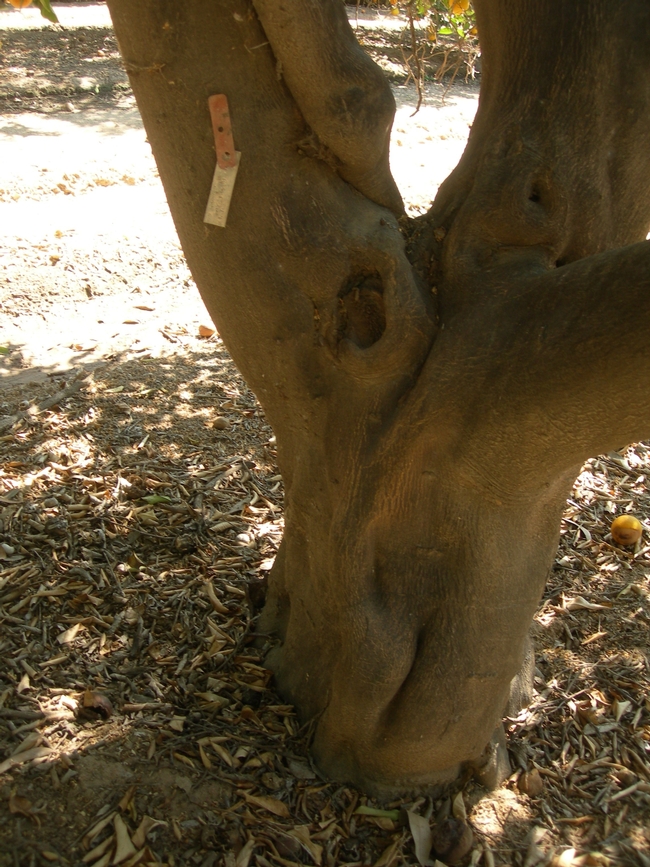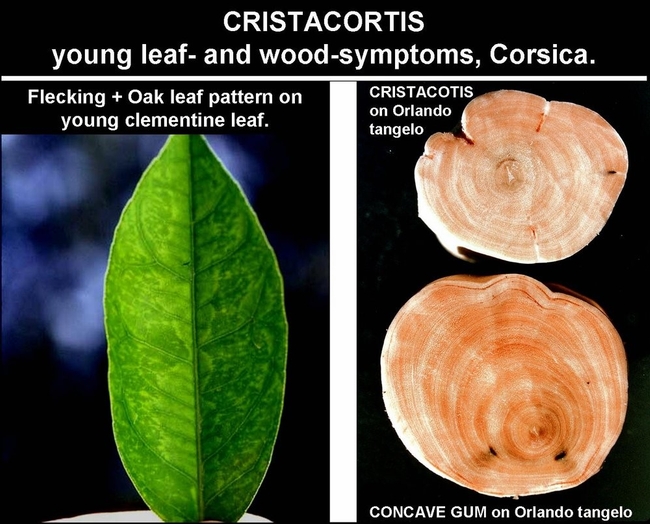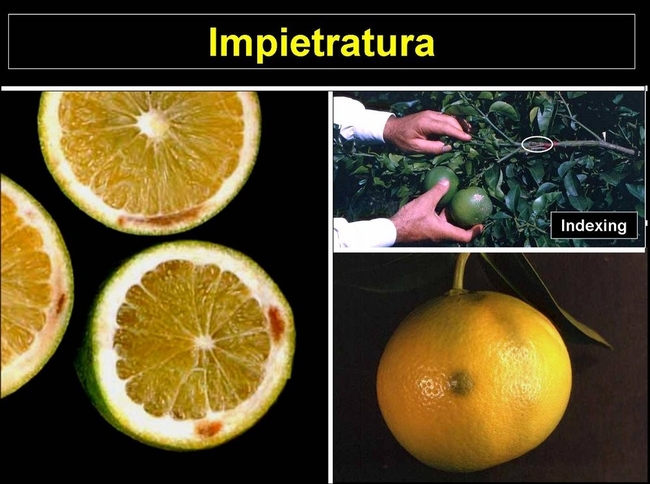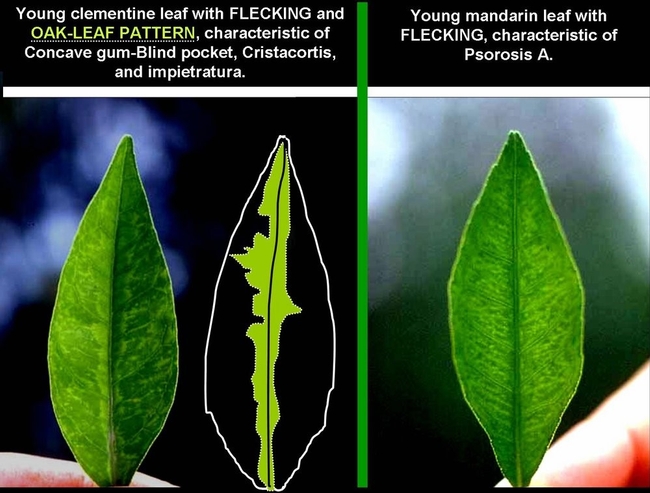The So-Called “Leaf Fleck” Virus Diseases of Citrus
Robert R Krueger, USDA-ARS National Clonal Germplasm Repository for Citrus & Dates
Riverside, California
Huanglongbing has recently emerged as an existential threat to California citrus production. Although thus far it has been apparently confined to Southern California residential citrus plantings and has not yet been detected in Central or Northern California, its potential for destruction has resulted in most of the attention paid to citrus diseases (as well as most of the research funding) being focused on Huanglongbing. However, other citrus diseases have historically been deleterious to citrus production and their elimination is required in registration and certification programs. It is therefore important to remain knowledgeable regarding these diseases.
One such group of diseases is sometimes referred to as the “leaf fleck” diseases. This is a reference to the symptoms produced in indicator plants in bio-indexing. Bio-indexing was, until relatively recently, the only manner of detecting these diseases, which have quite different effects from each other in commercial orchards. Recent advances in understanding these diseases were presented at the XXI Conference of the International Organization of Citrus Virologists (IOCV) held in Riverside March 09 – 12, 2019. A brief over-view of these findings and their historical context will be presented in this communication.
The diseases to be discussed include Concave gum (CG), Cristacortis, Impietratura, and the newly described Citrus virus-A. These diseases for the most part have historically been associated with the Mediterranean area. CG has historically been present in California, apparently introduced with a varietal introduction before stringent guidelines were in place. CG, Cristacortis, and Impietratura all cause the so-called “oak leaf pattern” in young, tender spring flushes of sweet oranges and mandarins when temperatures are mild. However, other symptoms and the economic effects of these three diseases are different.
Concave gum causes the formation of “concavities” in the trunk and larger limbs of infected trees (Fig 1). These concavities are depressions or pits that may be up to several square inches in size. In the initial stages of concavity formation, the bark cracks and exudes gum. Gum may also be present on the exterior of long-established concavities and within the trunk under the concavities. A portion of the xylem is plugged with these gummy exudates. The overall effect on the tree is generally not death but rather a general debilitation. Higher levels of concavities are associated with a larger degree of tree debilitation and decreased yield and fruit quality (Wallace, 1978).
Cristacortis (Fig 2) also results in pits on the trunks and main branches of infected trees. However, the pits are smaller, deeper, and sharper and occur in both the scion and rootstock. As with CG, the effect is a general debilitation of the tree and decreased economic performance. Impietratura (Fig 3) differs from CG and Cristacortis in that there are no vegetative symptoms. Infected trees have large numbers of small, hard fruits. Gum deposits are present on the albedo at the stem-end of the fruit and in the stem near the fruit. In some fruits, there is surface browning with gum present beneath the surface (Wallace, 1978).
What these three diseases have in common is the “oak leaf pattern” of leaf clearing seen in the leaves of sweet orange and mandarin under appropriate conditions (Fig 4). These symptoms can often be seen in the field and this led to the development of a biological index for this pattern (Roistacher, 1995). This consists of the use of ‘Dweet' tangor as an indicator, held under cool (65 – 75 ºF) temperatures in the greenhouse. ‘Dweet' proved to be a more sensitive indicator than other mandarins or sweet oranges. A problem is that the patterns in the indicator leaves are so similar that differentiation is difficult or impossible. Isolates are maintained based on the identification of the source trees in the field. Other diseases, notably psorosis, produce similar symptoms in indicators but the symptoms differ from the oak leaf pattern (Fig 4). This led to the association of these diseases and some others as part of a “psorosis complex” for many years. Since for most of these diseases, a causal agent had not been definitively established, disconnecting of the oak leaf pattern-forming presumed viruses was done based upon transmissibility, ability to cross protect, epidemiology, etc (Timmer and Beñatena, 1977; Wallace, 1978).
Recently, the di Serio group in Italy (Navarro et al, 2018a, b) and Vives in Spain (presentation at IOCV, 2019) have identified viruses associated with some of the leaf-flecking diseases and have developed laboratory assays for them. Navarro et al (2018a) identified a CG-infected tree by bio-indexing and excluded psorosis by molecular methods. Next-generation seque3ncing (NGS) identified an apparently new negatively stranded RNA virus, Citrus concave gum associated virus (CCGaV). CCGaV was originally said to be a member of the genus Phlebovirus, previously only reported in insects (Navarro et al, 2018a). However, further phylogenetic studies led to a proposal to create a new genus Coguvirus to accommodate CCGaV. A second virus from the proposed new genus Coguvirus was isolated and identified as Citrus Virus A (CiVA). A field survey in Southern Italy encompassing 71 trees showed 15 trees with CiVA present and 5 trees infected with both CCGA and CiVA. Ten of the trees were infected by CiVA and not CCGaV and were asymptomatic. CiVA did not produce symptoms in inoculated plants of ‘Dweet' tangor, ‘Madame Vinous' sweet orange, or other potential indicator plants (Navarro et al, 2018b).
At the IOCV conference, Vives reported Phlebo-like viruses associated with CG, Cristacortis, and Impietratura. A CG isolate (CG-24, originally from California) and an Impietratura isolate I-501 showed homology with CiVA, whereas Cristacrotis isolate C-601 (from Corsica) showed homology with CCGaV, based upon the sequences published by the de Serio group. At the same meeting, several other possibly-related viruses were discussed. Park from Texas presented an oak-leaf inducing virus that acted similar to a CG isolate CG-301 but grouped with CiVA was dubbed Citrus oak leaf associated virus (COLaV). Bester from South Africa described field trees that had psorosis-like trunk and limb symptoms but were negative for psorosis. Some apparent viruses were sequenced, some more like CCGaV and some more like CiVA. Cao from China described five new viruses that would also be related to CCGaV and CiVA that, converse to the South African report, produced leaf symptoms but no trunk symptoms.
These new developments are starting to shed some light on these previously mysterious diseases, but are also opening up new questions. Of particular interest in California is what we are calling CG isolates may in fact be CiVA isolates. This is confusing because the trees producing these isolates were those identified as CG trees based upon the field observations. Some of these trees are still maintained as field trees in Riverside. It is possible that the CG tree used by Navarro et al (2018a) to identify CCGaV had symptoms similar to our California CG trees but actually were caused by a different causal agent. However, our California CG isolates consistently produce symptoms in the ‘Dweet' indicator whereas CiVA did not (Navarro et al, 2018b). In any case, the new NGS methods have revealed interesting new insights into these interesting old diseases.
Literature Cited
Navarro B, Minutolo M, de Stradis A, Palmisano F, Alioto D, di Serio F. 2018a. The first phlebo-like virus infecting plants: a case study on the adaptation of negative-stranded RNA viruses to new hosts. Mol Plant Pathol 19:1075-1089.
Navarro B, Zicca S, Minutolo M, Saponari M, Alioto D, Di Serio F. 2018b. A negative-stranded RNA virus infecting citrus trees: the second member of a new genus within the order Bunyavirales. Front Microbiol 9:2340. doi: 10.3389/fmicb.2018.02340.
Roistacher, CN. 1995. A historical review of the major graft-transmissible diseases of citrus. FAO Regional Office for the Near East, Cairo.
Timmer, LW, and Beñatena, HN. 1977. Comparison of psorosis and other viruses causing leaf flecking in citrus. Proc Int Soc Citriculture 3:930-935.
Wallace, JM. 1978. Virus and viruslike diseases. Pp 67 – 184 in Reuther, W, et al (eds). The Citrus Industry. Rev ed. IV. Crop protection. University of California Div of Agr Sci, Berkeley, CA.
Fig 1. Concave Gum
Fig 2. Cristacortis
Fig 3. Impietratura
Fig 4. Oak Leaf Pattern



